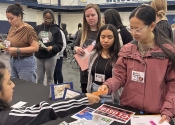
Healthcare students at CSM gain insight into living in poverty during simulation
OMAHA, Neb. – Healthcare students at College of Saint Mary (CSM) learned the realities for low-income families during a poverty simulation on campus.
“Being a healthcare provider, we deal with and are exposed to people with diverse backgrounds and from different walks of life. The poverty simulation sensitizes healthcare students to poverty,” said Tracey Toney, associate professor of nursing and lead lab coordinator. “When a patient is non-compliant, it may be because they have to choose between buying a prescription and feeding their family. This activity helps eliminate biases students might have had. They’re walking in the shoes of someone who lives in poverty.”
Poverty simulations allow participants to learn about poverty from the perspective of those who live it. The interactive experience aims to increase understanding of poverty, transform perspectives and inspire action.
The poverty simulation at CSM takes place every spring. Bachelor of Science in Nursing, practical nursing, Doctor of Physical Therapy, Occupational Therapy Doctorate and Master of Science in Physician Assistant Studies students participate.
During the simulation, first year students take on the identity of someone living in poverty. The identities are based on real life stories. They have to navigate childcare, banking, buying groceries, transportation, social services, healthcare and more.
“It’s every man for himself. There’s so much more that goes on than I expected. Going through this makes it more realistic and shows you how hard it is to get the resources you need,” said Blake Morgan, a physician assistant studies students. “If nothing else, it gives us a lot of empathy for patients in this situation.”
Second year students take on the roles of resource workers, providing support and highlighting the roadblocks people in poverty experience.
“You walk away with a sense of stress that this is somebody’s every day,” said Kayla Reed, a nursing student who has participated in the poverty simulation twice. “It allows us to see that this is real and not just in a textbook.”
The room that the simulation takes place in represents a community. The center of the room represents family homes and tables around the perimeter of the room represent community services and businesses.
Students experience what it’s like to live for a month in poverty. Each week takes place during a 15-minute session. During each session, students experience the daily stresses and challenges people in poverty face.
“It opens your eyes to what happens in the world and in our community. It prepares us as future nurses to have grace,” said Jasa Wiedel, a nursing student who has participated in the poverty simulation twice. “Here at CSM, we do a lot to promote caring for those around us and this shows how we can do that in our careers.”
Toney said the poverty simulation itself has impact, but students are encouraged to take what they learn and put it into action so that the activity has a lasting impact.











